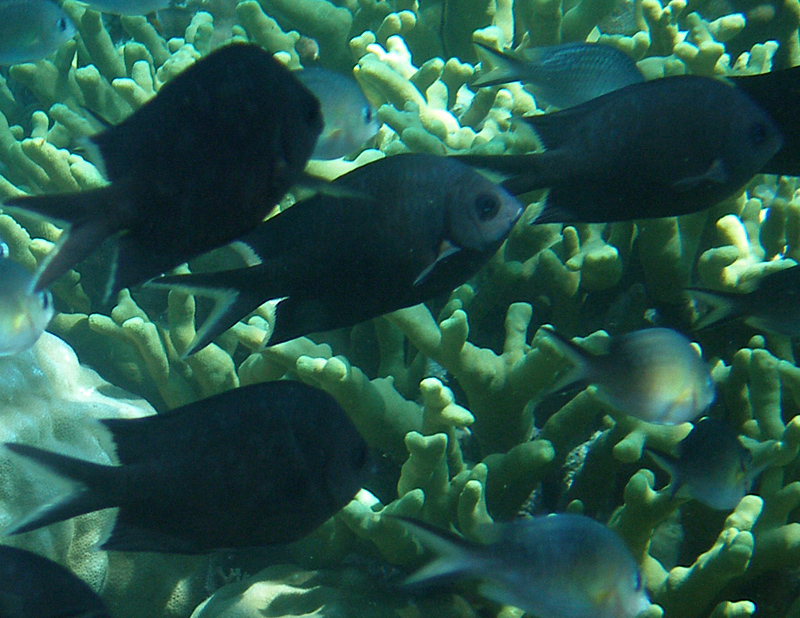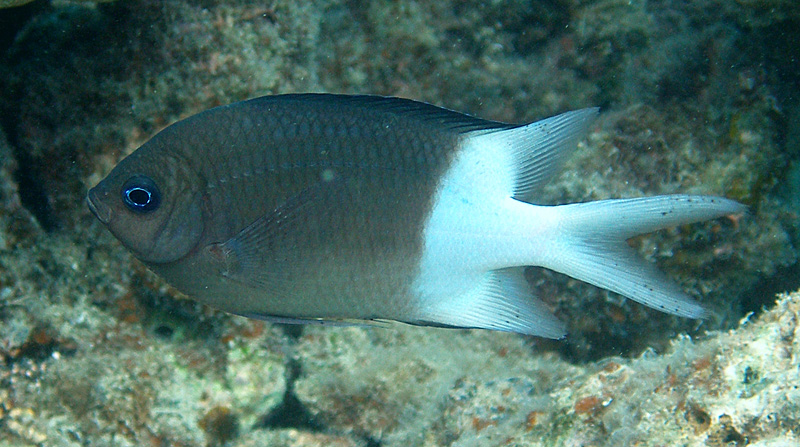
A school of juvenile Spiny Puller . At this stage they are no longer attended by the parents, and will soon disperse over the reef
Colours
Distinguishing features
A small fish with a laterally compressed body that is grey on the front 2/3 and white on the rear 1/3. Usually seen in small loose schools near heads of live coral or other underwater structures.
Size
- Up to 14 cm (Standard length)
Depth range
- Depth range data is not yet available.
Synonyms
Distribution
Distribution and habitat preferences
Favours areas of rich coral growth in with good current flow, however this species is found in almost all reef habitats around the island.
Found in most locations around the Island.
Behaviour
Spiny Puller are extremely widespread and common across the GBR from the inshore fringing reefs right out to the Coral Sea atolls, and this species has a number of colour variants.The fish in the Coral Sea are all white, whereas on the southern GBR and in Papua New Guinea they are all Grey-black. The Spiny Puller is very unusual in that it does not have a pelagic dispersive larval phase, and this feature has a number of implications for the development of the larvae and the parental reproductive biology. The eggs are large and take 15-17 days to hatch, compared to about 5 days for most other damselfish. The newly hatched larvae are also relatively large with well developed tails, and can swim and remain in a tight school close to the nest site immediately. They are guarded by the parents for several weeks, and then they gradually disperse over the local reef once they reach a large juvenile size. This has implications for the genetic mixing of the populations of this species - the GBR population is far more heterogenous than other damselfish with a dispersive larval phase. The species is also unusual in its diet, feeding both on plankton and algae. The algae may be drifting in the water, but the fish is also a very efficient robber of algae from the farms of Pomacentrus wardi and Stegastes nigricans.
Web resources
References
- Arnal, C. (2000). Ecologie comportementale de la symbiose poisson nettoyeur/ poisson client: motivations et honnêteté, Ph.D. thesis, University of Perpignan, France. LIRS catalog number 637.
- Bay, L.K. (2005). The population genetic structure of coral reef fishes on the Great Barrier Reef, Ph.D. thesis, James Cook University. LIRS catalog number 967.
- Bay, L.K., M.J.M. Caley and R.H. Crozier (2008). Meta-population structure in a coral reef fish demonstrated by genetic data on patterns of migration, extinction and re-colonisation, BMC Evolutionary Biology, 8: 248-264. LIRS catalog number 1180.
- View all references




